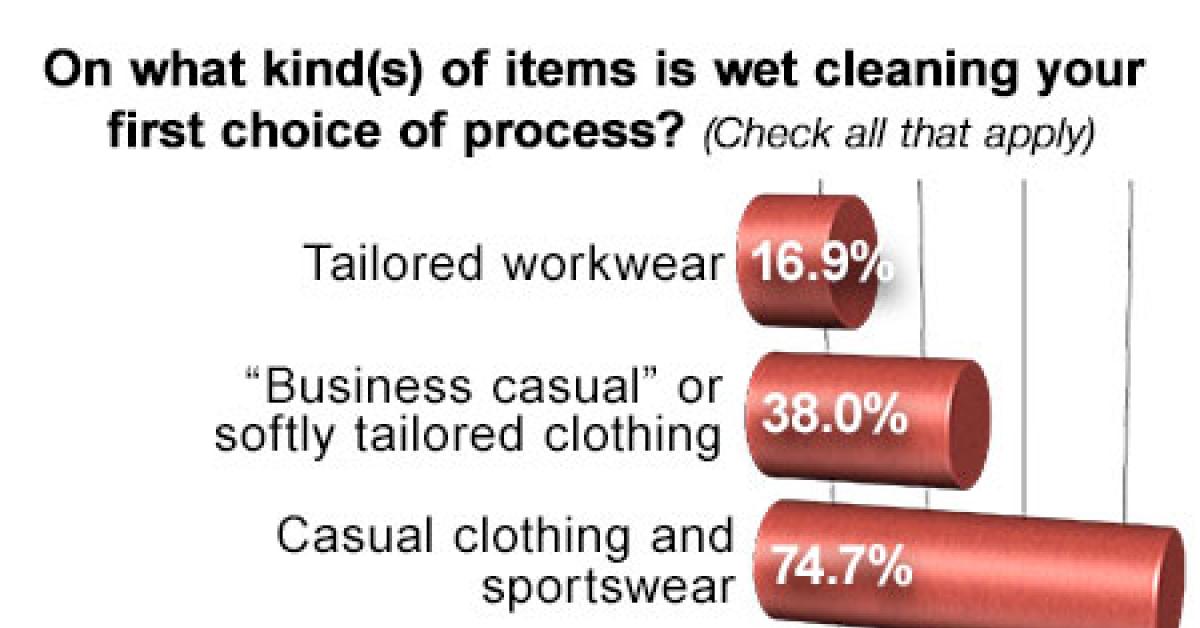CHICAGO — More and more dry cleaners are using professional wetcleaning techniques in their plants, with the majority (26.4%) saying they use the process on as much as 20% of the volume they clean, according to results from this month’s American Drycleaner Your Views survey.
Roughly 19% of respondents say they use wet cleaning on more than 40% of their plant’s volume. Approximately 18% use it on 21-30% of garments they process, and 15.3% use it on 31-40% of garments. Close to 21% say they wet clean “less than 10%” of their overall volume.
Wet cleaning has become the go-to process for dry cleaners when cleaning casual clothing and sportswear (74.7% of respondents use the process for this category); specialty items, like draperies and gowns (42.3%); “business casual” or softly tailored clothing (38%); restoration work (25.4%); and tailored workwear (16.9%).
Roughly 6% of respondents say they do “nothing but wet cleaning,” while 16.9% listed “other” items they primarily wet clean, such as polyester suits, down comforters and “items with heavy water-soluble stains.”
Utilizing wetcleaning techniques is not easy on all types of fabrics. Cashmere, silk, rayon and wool present some difficulty when doing so, according to the dry cleaners polled.
“We tend to only dry clean [silk and wool] as we have a drycleaning machine, and they require less work this way,” says one respondent.
“Wool and the mix textiles [are difficult to process because] the texture or feel of fabrics change,” says another. “Wear and tear are accelerated since water is [harsher] on fabrics.”
“As the state of Illinois has a solvent tax and license fee, using less solvent is essential,” says one dry cleaner. “Also, water is included in my lease [so] wet cleaning saves my business money.”
Others echo this sentiment, lauding the benefits of the process.
“Wet cleaning has reduced our costs as we purchase less solvent, less filters and all other costs associated with dry cleaning,” a respondent says.
“Wet cleaning has been a great addition to our cleaning arsenal,” adds another.
While some respondents say they strictly process garments through wetcleaning techniques, others countered by saying that it should only be used as an alternative, with one stating that it is “not a good all-purpose option.”
“I do not believe that wet cleaning is the best method for all garments,” one says. “Some fabrics and fibers need to be dry cleaned.”
“Although wet cleaning has its benefits, [it] cannot be the only method a cleaner can rely on,” adds another. “Certain fabrics [like] wool and silk just benefit from dry cleaning.”
While American Drycleaner’s Your Views survey presents a snapshot of the trade audience’s viewpoints, it should not be considered scientific. Due to rounding, percentages may not add up to 100%.
Subscribers to American Drycleaner e-mails are invited each month to participate in a brief industry survey they can complete anonymously. The entire American Drycleaner audience is encouraged to participate, as a greater number of responses will help to better define owner/operator opinions and industry trends.
Have a question or comment? E-mail our editor Dave Davis at [email protected].

